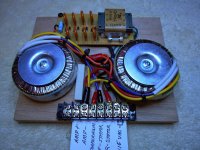I am building Jazzman's simple bias supply and Mouser was short on the capacitors that were in the parts list so I swapped out the 75-564R30GASS10 with a 75-564R30GAS10. The only difference "other than price" being that the temperature coefficient is rated Y5U instead of Y5V. To my understanding the Y5U is just more efficient at high temperature... but in the black art of audio high voltage, maybe I'm missing some benefit of the Y5V. Hoping someone more qualified can confirm or deny my assumption. Thanks
It is not about efficiency, more about survivability.
It is most likely that both caps are identical and come from the same production line. After production the test for leakage current allows one to be rated at up to 50V and the other at 75V.
They will both probably be able to work at < 50V without any measureable differences.
This is a (n hopefully intelligent) guess as I am not able to look up the datasheets ATM)
It is most likely that both caps are identical and come from the same production line. After production the test for leakage current allows one to be rated at up to 50V and the other at 75V.
They will both probably be able to work at < 50V without any measureable differences.
This is a (n hopefully intelligent) guess as I am not able to look up the datasheets ATM)
The Y5U will change capacitance value slightly less over the full (-30C to +85C) operating temperature range than the Y5V.
Considering the temperature range likely to be seen by your ESL supply, the capacitance isn't gone change much anyways.
cheat-sheet for temp codes attached.
Considering the temperature range likely to be seen by your ESL supply, the capacitance isn't gone change much anyways.
cheat-sheet for temp codes attached.
Attachments
Thanks bolserst, So the Y5U would be a slightly better choice if I was running at the hotter end of the scale... more stable anyway.
It is not about efficiency, more about survivability.
It is most likely that both caps are identical and come from the same production line. After production the test for leakage current allows one to be rated at up to 50V and the other at 75V.
They will both probably be able to work at < 50V without any measureable differences.
This is a (n hopefully intelligent) guess as I am not able to look up the datasheets ATM)
?? Voltage rating is about dielectric breakdown. Higher voltage means thicker dielectric means larger cans. I agree that either cap will work fine.
Yet another noob inquiry about the phasing this time. In Charlie's bias supply the 115 voltage is marked on the schematic as having the hot wire on the fuse side, but in the build both wires are green and there is no pos neg marking on the lugs. That leads me to wonder if the polarity is irrelevant with the power going in. If you reversed the pos neg wouldn't that reverse the polarity of the phasing? Just curious.
Attachments
- Status
- Not open for further replies.

